JRDG Company Special – Concerto integrated
Available around 2007-2008
Retail price in the Netherlands in 2007 – 7198 euro
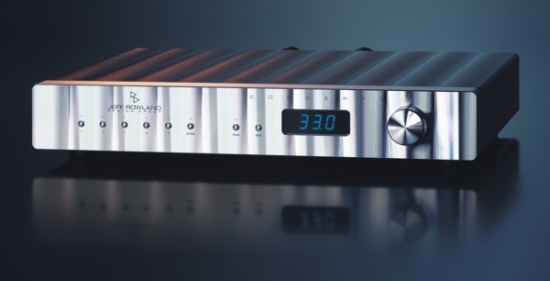
Introduced after the Concerto Proyotype, the Concerto was in production for only a short time. It has also vanished from the Rowland site, as if it never existed. But it has actually been around for a couple of years. It was available as preamp and as an integrated amp. It had a Synergy-derived preamp section with transformer-coupled inputs and a linear power supply. Two added ICE-Power modules turned it into an integrated amplifier.
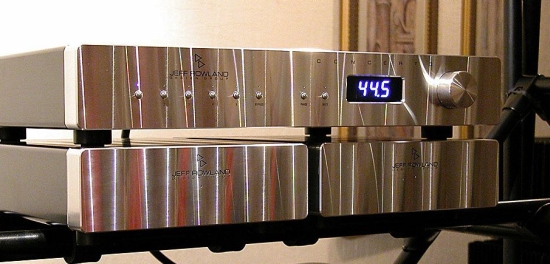
Above: Concerto on top of two 201 monos

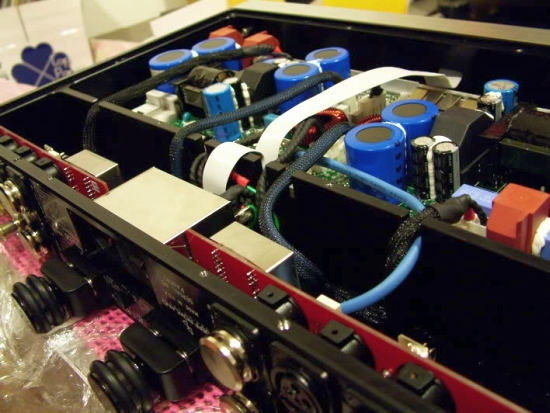
Note that in the integrated version of the Concerto, preamp version’s linear power supply is not present. Likely the preamp section is now fed from the ICE modules’ powersupply.
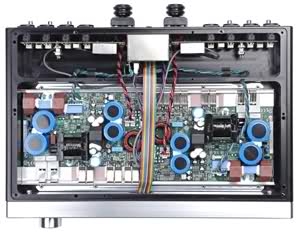
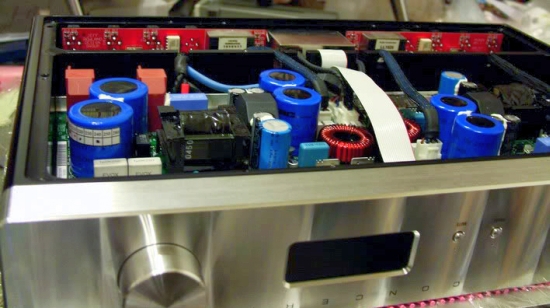
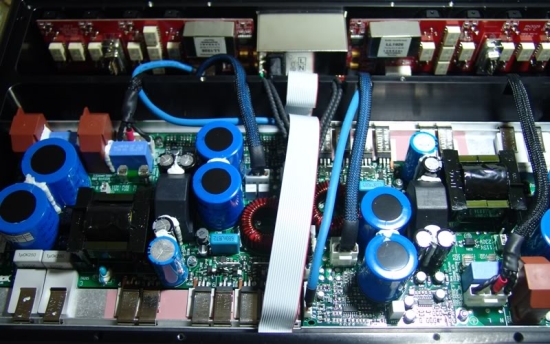
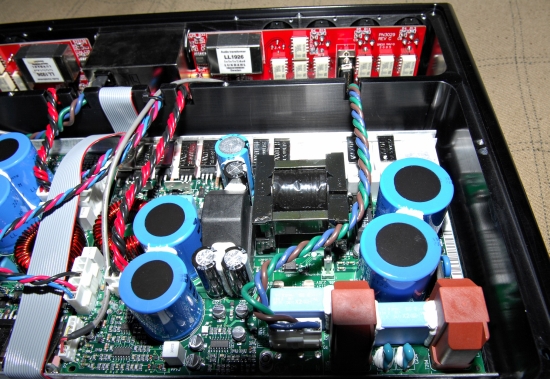
The text below has been re-published from content that was formerly available on the official Jeff Rowland website.
The third generation of integrated amplifier from Jeff Rowland Design Group, the Concerto, is built upon the accumulation of line level and power amplifier knowledge during more than 20 years of amplification design. In the world of high-end audio product design, integrated amplifiers are generally considered the “budget” or entry- level components from most manufacturers. Though the Concerto is the least expensive way to complete the control and amplification portion of an audio or home theater system, it will by no means be a limiting factor in sound quality. The Concerto spares the user excessive heat, burdensome size, and unattractive physical design while at the same time sparing no reasonable expense to provide the best possible sound quality.
The input section of the Concerto is derived from the acclaimed Synergy IIi preamplifier and utilizes a pair of audio input transformers custom designed with the assistance of Jeff Rowland Design Group using the latest in computer aided drafting techniques (CAD). These transformers enable the input section to accomplish a number of unique goals, including insensitivity to unbalanced source impedances, high common-mode rejection extending to well beyond the audio bandwidth, and the same input impedance and gain regardless of whether the balanced or unbalanced input terminals are used.
From the input section, the delicate audio signal is then handed to an ingenious input switching and volume control circuit. The volume control within the control circuit uses the most accurate and sonically neutral system available. A digitally-controlled analog volume control is used to provide exact matching between both channels at every volume setting, as well as allowing the absolute simplest signal path possible. For each volume setting, the audio signal passes unscathed through only a single resistor. This unique system never suffers from the numerous problems found in conventional potentiometer controlled volume controls, including varying impedance and tracking accuracy, and avoids the issues associated with the use of DACs as volume controls, such as the distortions created by their internal polysilicon resistors. Behind the faceplate of the Concerto, the volume knob is attached to a laser cut optical encoder wheel that is read by a light sensitive diode. Based on the information received from this diode, the microprocessor within the unit determines the knob rotation speed and raises or lowers the volume in either large or small increments for the most accurate and transparent volume control possible in the audio world today. The exact number of precise, 0.5 dB steps are then sent to the volume control circuitry on the rear panel to keep the audio signal path as short and distortion free as possible. The volume level is displayed by a soothing, blue seven-segment LED display that is easily read from the listening position. When not in use for more than 5 seconds, the volume control and display circuitry revert to a sleep mode to prevent any audible interference or distortion from corrupting the audio signal.
A pair of unity gain Bypass inputs enables the Concerto to interface seamlessly into any multi-channel or home theater system. Providing direct connection to the main amplifier outputs, the Bypass inputs allow the volume or level control of a multi-channel processor to drive the amplification section of the Concerto and side-step the preamplifier section of the integrated amplifier entirely with the press of a button. The ability of the unit to operate as either an amplifier or integrated amplifier equally well makes it the ideal choice for any music lover looking for a way to also enjoy the best possible film score reproduction.
The amplifier output section of the Concerto utilizes two output modules featuring the latest in high-powered switching-output technology. Developed by ICEpowerTM, these output circuits are used in place of standard output transistors to provide unprecedented audio performance, stability, efficiency, and reliability virtually impossible to achieve with conventional discrete components.
This technology breaks previous performance barriers in both conventional analog and present digital Tripath (Class T), Class D, or Pulse Width Modulation (PWM) systems. It utilizes novel modulation techniques and error correction topologies known as Multivariable Enhanced Cascade Control (MECC) and Controlled Oscillation Modulation (COM). MECC is used for control and error correction of frequency response, distortion, noise, and output impedance, while COM offers a number of distinct advantages, such as better distortion specifications, greater bandwidth, higher efficiency, and a much simpler overall circuit in comparison to previous conversion techniques, such as Class D operation. The overall circuit operates primarily by enabling extremely precise control of all parameters in the output section and, thus, produces exceptional distortion specifications with relatively simple hardware. The Concerto’s output section cannot truly be called Class D, and, in fact, is new and innovative enough to not yet be described by classification at this time.
Problem Solving
Coherence, Synergy, Concentra, and Concerto IR Remote Control lock-up
The remote controls for the above listed products have an internal capacitor that can cause the microprocessor to lock when the battery has been nearly drained. This problem will continue even after a fresh battery has been installed. This capacitor allows the remote to continue to function even after the battery has become very weak. The solution to this problem is simple: remove the new battery and allow the remote to stand overnight with no battery installed. Once the battery is reinstalled in the morning, the remote should function properly again.
Features and Specifications
No manual available, see Concertro Preamp for info regarding the preamp section
More Jeff Rowland
Jeff Rowland Company Special Main Page
Jeff Rowland Company Special Integrated Amplifiers
Very nice description! But how does it sound? Maybe in direction of 102?
I’ve only owned the Concerto preamp, not the integrated version. However, knowing that unit, as well as the 102, and knowing that an ICE module is used, I bet that the combination does indeed sound like a 102, driven by an excellent, powerful and neutral preamp.
Good Day!
How much is the current estimated price of this amplifier?. Actually, I have this one but I prefer to sell it because I’m no longer need it. I hope you respond to my query.
I would be inclined to say maybe 2500-3000 euros but I have rarely seen a Concerto integrated for sale and thus have no good idea of its current value. Your best bet is to check Hifishark and if there are no current offerings just check the sold/expired section.